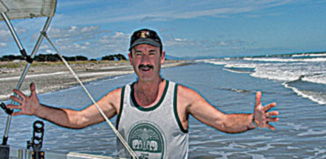
Born and grew up in Ranfurly, Central Otago, Trevor Hunter was the eldest of three children. Dad was a joiner, and when he left school, Trevor Hunter took up an apprenticeship with him. After coming out of his time, Trevor spend 4 more years in dad’s joinery factory, then went into partnership with a friend, and ‘went building’.
Ranfurly, heart of the Maniototo, beloved of painter Grahame Sydney had a population of 2,500 servicing the farming community. Summers were fiercely hot, winters freezing cold, with the ground often covered in snow. The decline of the mid eighties hit Ranfurly badly, and Trevor’s building partnership dissolved in 1986. He applied for a job at Ranfurly Hospital, doing building maintenance. Part of the job required him to drive the big International ambulance.
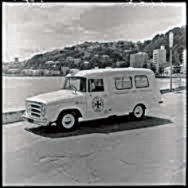
No medical training was given as in those days there was a ‘driver’ and a nurse. The catchment area of the job covered 80 km, and with a hospital nurse by his side, Trevor was often called out to fetch sick or injured patients. Emergency health care was pretty minimal 30 years ago.
By this time, Trevor had married Janet, a teacher from Dunedin, and started a family. When the Health Board joined up with St Johns, Trevor was asked ‘do you want to be anambulance officer?’ At the age of 33, he said he’d give it a go, and was sent to Auckland for three months training, followed by three weeks at Dunedin hospital. Today, to qualify as an ambulance Officer requires a 3 year degree course: back then twelve weeks was it! This provided the basic qualification and others followed.
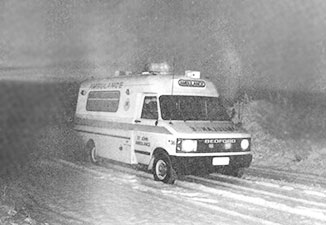
His first job was to set up St John ambulance in Ranfurly. He recruited and trained 14 volunteers, some of whom were hospital nurses moonlighting from Ranfurly Hospital. Matron was not impressed! In 1998 the ambulance was replaced with a Bedford.
Trevor, now equipped with a pager still had his day job maintaining the Hospital Boards 7 properties. They paid his salary, and were reimbursed by St John for Trevor’s call-outs.
After eight years, Ranfurly was in decline. The railway lines had long since been ripped up, and the Central Otago Rail Trail was only a gleam in someone’s eye. The Hunter family, with 2 school-age children were ready for a change. Their plan was to spend two years in the North Island. Trevor decided to apply for a job as Paramedic ‘anywhere but Auckland’. MidCentral had four positions. There were 70 applicants, and Trevor was offered Otaki. In 1994 St Johns were based in the annex behind the Maternity Home, where the Menzshed now resides. ‘Minimal comforts’, recalls Trevor. There were two paid staff, both on a 96 hour roster: four 24hr days on, four off. The mantra was ‘pick up anambulance, wait for a call on your pager’.
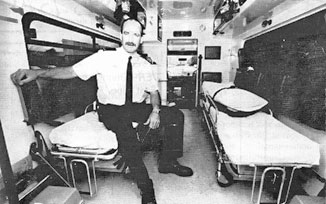
Trevor got a call from Ian King, chief of Otaki’s Volunteer Fire Brigade: ‘you were a volunteer fireman, weren’t you? How about joining the Otaki brigade? Trevor had been a fireman since 1970 until he had to resign due to the demands of St John. In Ranfurly the brigade handled 30-40 call-outs to fires a year. Otaki, with a bigger population has up to 150 callouts annually. There’s a lot in common between firemen and St Johns people — ‘all good blokes’ remembers Trevor. He retired from the brigade in 2012, after 33 years as a volunteer fireman.
In 2002 Trevor was burnt out, and resigned from St Johns. ‘I’d had a gutsful’. The job disrupted family life, and the organisation disillusioned him. He took up building again for a couple of years, but became aware that things were happening in St Johns. Things were changing for the better, shift work was more organised and conditions were improving. He re-applied for a job at Otaki, but missed out, so he joined St Johns in Wanganui. How did he manage? ‘I went flatting in Wanganui’ he said. ‘Four days on, four off’. Janet reckons it was great, and our marriage blossomed’.
After six months, there was a big reshuffle in St Johns, and the Otaki Station Manager’s job came up. Things were significantly better: four fulltime paid staff, 12–16 volunteers, with the day shift manned 6am to 6pm by two paid staff, nights by a paid Officer and a volunteer. ‘Our’ St Johns area covers from Peka Peka northwards. and a typical working day might involve calls from Otaki, Feilding and Palmerston North under St John’s ‘fluid deployment’ regime.
Today, 75% of a St John officer’s work is ‘routine medical’. There are fewer road accidents than there used to be, and most of the work involves health issues, which cover accidents to cardiac arrests. There is a greater emphasis on medical knowledge. Trevor will do some more Health papers at Whitereia to keep abreast of the changes in health care. At 61, will he keep going? Yes, you can’t keep a good man down.
These days St John is a good employer, and now offer opportunities for job sharing, so Trevor will carry on as long as he can.
Last October, Trevor was working outside at home when he experienced a crushing chest pain. His training told him it was cardiac, and he managed to get to a phone and call 111. The ambulance arrived 10 minutes later. At Palmerston North, a heart attack was confirmed as the ‘widowmaker’ and he had open-heart surgery. After some months of recovery, he’s back to normal, and now can see the wotk of St John from another perspective.

There’s another side to Trevor Hunter — fisherman. For over 10 years he’s been a member of the 120-strong Otaki Boating Club. ‘All good people’ he says. Trevor was elected chair in 2010. For the past decade he’s had a 16 foot aluminium boat and a tractor parked out the back of his house, and reckons he can have the boat in the sea in 11 minutes. Does he go out by himself? ‘No’, he says, ‘Always take someone out with you for safety.’ What does he catch? ‘Snapper, Gurnard and Kahawai’ was the answer.
What’s St John all about?
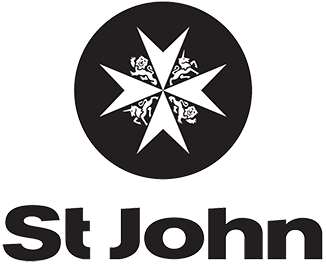 It’s a charitable organisation that has existed in NZ since 1885, and is believed to trace back to the Crusades.
It’s a charitable organisation that has existed in NZ since 1885, and is believed to trace back to the Crusades.
St John providesambulance services, health shuttles, community services at sports events, first aid training and medical alarms.
It is part-funded by government and District Health Boards, so you may have to pay forambulance services.
- A family can become a member of St John for $60 per annum, which entitles you to free services.
- It you’re not a member and need anambulance, you will have to pay $88.
- Last year, St John treated and transported nearly 400,000 people.
- At 205 St John stations they have 610ambulances that average nearly 35,000km annually.
- There are 1,200 paid St Johnambulance officers like Trevor Hunter.
- There are 2,800 volunteerambulance officers and over 8,000 St John volunteers.
St John providesambulance services for 90% of NZ’s population. (Wellington Freeambulance is an anomaly) If you live South of Peka Peka, that’s who will assist you.
Over half of Otaki’s volunteers commute from Wellington as we’re the nearest St John station. They don’t get paid, just get a $20 reimbursement per shift.

